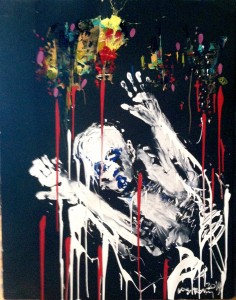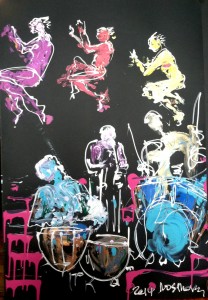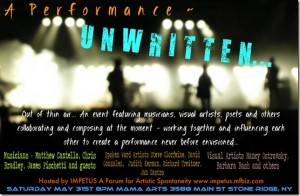I had no hint from the announcement that an intense new love affair awaited me. It was called “A Performance Unwritten,” for an event on May 31 at a venue called MAMA Arts in Stone Ridge, New York. Its premise was that artists in various media and forms, most of whom had never worked together before, were going to create an evening of entirely improvised art. Well, no thanks, but that doesn’t sound like my bag, man…
…except that my poet friend Judith Kerman was one of the artists involved. And it was on an evening when I had nothing else planned. And it might be something that my wife, who has Alzheimer’s Disease, would enjoy, since it sounded as though it would be visually stimulating and she usually enjoys music.
When we got to Stone Ridge, my suspicions were immediately aroused by the venue. I’d never been there before, and it didn’t look like a very well-organized place. But the event attracted a fairly good-sized audience, and as soon as the trio of musicians started to play I knew I was in for an enjoyable evening, since they were quite good. As the performance progressed, some of the spoken word improvisations were involving (especially, I must say, Judy’s), some less interesting, but the music kept things lively.
And then there were the painters, one on each side of the hall. One of them was doing some pretty interesting work. The other looked at first as though she was just splashing and dabbing paint on a large black board, using several methods to get paint onto the board not including a brush. Just as I decided the work was going to be nothing but abstraction, she put her hand into white paint and pressed it down, and as she lifted it off I realized that her handprint was at the end of an arm and she was creating a figure.

That moment of recognition threw a shock into my system. I was reminded of the time, half a century ago, when I heard my first Cecil Taylor record. A jazz critic friend played it for me, telling me he thought Taylor was the next great thing in jazz. I listened with increasing puzzlement as some guy seemed to be throwing his hands at random around the piano keyboard, until I suddenly realized that an impossibly complex figure ran up and down the keyboard and was then repeated exactly. The understanding that Taylor was in complete control of everything he played forced me to listen with different ears.
I had that same realization about the work of Nancy Ostrovsky. Throughout the remainder of the performance I couldn’t take my eyes off her. After she finished the first painting, she took it off the easel, rested briefly, and then started throwing paint around again. This time, she was creating a picture of the musicians and some dancers who briefly participated in the performance.

It was art love at first sight. At the end of the performance, I rushed over to Ostrovsky and asked how much she wanted for the paintings. The price she quoted seemed quite reasonable. I handed her some money as a down payment on the one I had decided I wanted. (It turned out, not surprisingly, to be a little less than it’s costing me to frame it!)
Perhaps I should have bought the figure. It was the painting that gave me that thrill of discovery. But I decided I would have more fun looking at the musicians. I look forward to having them as companions for a long time, and to seeing a lot more of Nancy Ostrovsky’s work. When I went to her studio to collect my painting–she wouldn’t let it go immediately because she wanted it to dry properly–I saw a lot more of her work. One impressive item was a copy of a poster for a Dizzy Gillespie concert, inscribed to her by Gillespie.
After I told some friends about my great experiences at the Southampton Writers Conference, where I got to take a workshop with Billy Collins, I got puzzled responses from some people who aren’t typical poetry consumers. They were curious to know how anyone could teach you to write better poetry.
Igor Stravinsky once said that, if he were to create a textbook on orchestration, he would have to use only examples from his own music, because those would be the only ones where he could tell if the orchestration was successful. Similarly, my poetry is the work I am most intimately acquainted with.
Here is the text of one of the poems I brought to the workshop for a critique. I brought it because I thought it was unsuccessful, but I cared enough about it so that I wanted to make it work:
Badges
She’d been very sick,
the neighbor across the street
whose husband died so young.
Then she was better again.
I saw her in her garden
just last September,
working with a younger friend,
smiling.
Next summer you can help, she said.
I said I would.
Then I didn’t see her for a while.
Now I see strangers’ cars,
five or six at a time.
Some of the people wear badges.
They rush through the light snow.
They do not look like
they want to answer questions.
The people in the workshop, including Collins, were complementary about the first two thirds of the poem, pointing out its values of compression and good selection of detail. They didn’t like the stanza breaks for single lines, which I agreed were unnecessary. And the line “working with a younger friend” was too general, so I changed it to “pulling weeds with a younger friend.”
The last stanza, though, did not convey what I wanted it to. The image the readers got, except for one person who understood my intentions, was of emergency workers coming to help with a desperate situation. That wasn’t my intention, and it didn’t make sense in the context of the poem either. I explained that what I wanted to convey was my experience of seeing these people across the street and realizing that they were hospice workers and that my friendly neighbor was dying.
The first detail I got objections to was “five or six at a time.” I had actually seen that many at once, but truth in itself doesn’t justify its inclusion in a poem. Fewer cars was the recommendation. The badges didn’t compute for most people. They didn’t understand I had meant to indicate name tags that medical workers wear. And the detail of rushing through the snow, even though the people had actually rushed–probably just to get through the snow faster–contributed to the impression of an emergency. Collins’s remark, one he made many times during the course of the workshop, was that there were too many cards left face down on the table. It surprised me at first, since I aim at a plainspoken style without obscurity. But I realized that obscurity isn’t only a problem of language. In this case, it was a problem of the selection of detail, which had been so much more successful earlier on in the poem.
After I assimilated the various comments (many written out on the copies of the poem people had read), I revised the poem as follows:
Badges
She’d been very sick,
the neighbor across the street
whose husband died so young.
Then she was better again.
I saw her in her garden
just last September,
pulling weeds with a younger friend,
smiling.
Next summer you can help, she said.
I said I would.
Then I didn’t see her for a while.
Now I see strangers’ cars,
two or three at a time.
Sometimes people sit in their cars
writing notes.
Some of the people
wear name badges on cords.
They trudge through the light snow.
They do not look like
they want to answer questions.
This version, I think, gives the reader a serious chance to understand my intentions, and to share in a small way the experience of discovery. If I find out there are other places in the poem which obstruct that experience, I’ll be revising again.
Incidentally, I recommend Ted Kooser’s Poetry Home Repair Manual, among numerous fine books on the writing of poetry.
The first thing you notice is
the smell of what they use to chase away
the smell of illness and decay.
It’s not pleasant,
like over-ripe fruit blended with dollar-a-gallon vinegar.
The lights are always on.
The hospital’s trust fund invests heavily in utility stocks.
When the power blacks out
generators roar into action
keeping blood flowing through the building’s veins.
If you want to get a nurse quickly
push the panic button
and tell her a light went out.
Tell your visitors:
don’t touch–
me,
the walls,
the chairs,
the floor,
the sinks,
the food.
Hospititis lurks everywhere
and drugs don’t cure it.
For five bucks a day you see on TV
the same blurry people from antenna days
still saying the same things
only now you can’t hear them.
The basic food groups are:
anonymous cereal
dry white toast
jello
skim milk
coffee
pills
capsules
stuff that spurts out of needles.
Nurses come to get you up and walking.
Then they put you back down like a dirty sock.
Most of the nurses come from far away.
Some of them have accents
that seem to come from outer space.
Those aliens are the nicest ones.
The billing department always gets something wrong.
Then, months later, more bills come
from ghost doctors who died years ago
but still have good reputations.
Four or five or six or seven times an hour
a loud tinny noise gushes from a box on the wall.
It sounds like it’s squeezed from a rusty tube.
Are those words?
All in black, the chaplain walks in,
introduces himself, mumbles, smiles, walks out
just like he did yesterday
and will do tomorrow.
Today’s the day!
It’s like getting out of jail.
They give you back your clothes
but where are the $20 bill and the bus ticket?
Every month, reminders arrive
from the Alumni Association
asking you to remember your vacation
with a generous contribution.
We contribute them to the recycling bin.
This poem is from my “Dystopias” series.
This post makes my 52nd week of weekly posts. I had promised myself I’d do it weekly for a year and I did. Since I am about to get busy for a little while, including a visit to the Dodge Poetry Festival, this blog may become less regular for a while. However, I’m not quitting. And you’ll still get notices whenever a new blog is posted. Thanks for reading. –LG
The great Polish poet Wisława Szymborska died last week at the age of 88. You can learn a great deal about my own taste in poetry, and ambitions for my own work, when I mention that she was one of my favorite poets ever.
Since Szymborska dealt so profoundly with the life of ordinary things, I’ll start off by telling you how to say her name correctly. That funny symbol of the L with the line through it, which I believe may be unique to the Polish language, is pronounced like a W in English. The W in Polish, as in some other languages, is our V. So her name is pronounced vis-WA-va shim-BOR-ska.
I am not really equipped to write an analysis or appreciation of Szymborska’s poetry. That task has already been accomplished satisfactorily by Billy Collins, in his introduction to “Monologue of a Dog,” the first collection of her work published in English after she was awarded the 1996 Nobel Prize for Literature. (Her friends referred to that event as the “Nobel Tragedy” because she stopped writing for several years after the prize was awarded.) Here’s the quote that appears on the dust jacket: Szymborska knows when to be clear and when to be mysterious. She knows which cards to turn over and which ones to leave facedown. Her simple, relaxed language dares to let us know exactly what she is thinking, and because her imagination is so lively and far-reaching–acrobatic, really–we are led, almost unaware, into the intriguing and untranslatable realms that lie just beyond the boundaries of speech.”
Collins is a profound fellow, despite the conversational nature of his prose and poetry, and he has given a good definition of poetry here, at least poetry as I conceive of it: “realms that lie just beyond the boundaries of speech.” That’s why I cannot summarize one of Szymborska’s poems–not only because they are so concise, but because in their selection of images, their unconventional thoughts, and their precise expression, they are indeed beyond the boundaries of speech. That paradox–using words to express what lies beyond words–is the nature of great poetry. Szymborska travels in that land very often, and in moving and surprising ways. And although I read her only in translation, I feel that I do understand what she is getting at. The concepts come across.
Although half of “Monologue of a Dog” is wasted on us because it includes the Polish originals of the poems as well as translations, I still recommend it as an introduction to her work. If you want to see how this modest woman, working in obscurity as an editor at a Polish literary magazine, developed her unique voice, you can get either of the earlier English language collections, “Poems New and Collected” or “View with a Grain of Sand.” Both volumes include a lot more poems than “Monologue of a Dog,” and both include many examples of the work Szymborska did–including much rhyming verse–on her way to mastery. But “Monologue of a Dog” is all masterpieces. It includes the great title poem, which shows how the choice of a limited perspective (a dog’s) on human activity illuminates human experience; “A Few Words on the Soul,” as amusing as it is a profound exploration of human nature; and the heartrending “Photograph from September 11,” in which a few words recreate the awful experience of that day with the most beautiful compassion and sorrow. These poems are magic tricks as much as they are explorations of the experiences we share.
If you don’t know this magnificent poet, even if you are usually not a poetry consumer, take a few minutes to read some of her work. These poems may not change your life the way they have mine, but the will put you in touch with one of the most beautiful people ever to walk our planet.
You can find out more about Wislawa Szymborska on the Culture.pl page about her at http://www.culture.pl/web/english/resources-literature-full-page/-/eo_event_asset_publisher/eAN5/content/wislawa-szymborska

